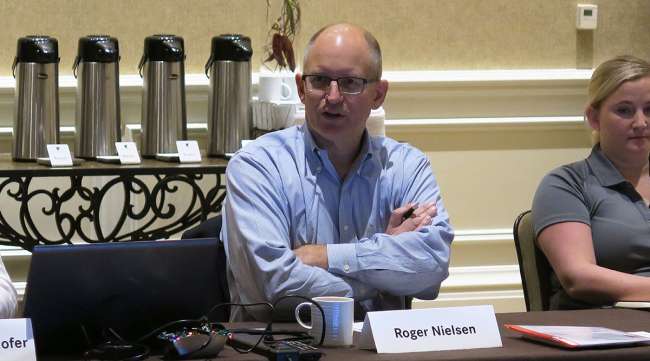Managing Editor, Features and Multimedia
DTNA Pursuing Advanced Driver-Assist Tech, not Autonomous Trucks, CEO Says

ORLANDO, Fla. — Daimler Trucks North America continues its pursuit of automated driving technology, but that development path is focused not on “autonomous” trucks but advanced driver-assistance systems, CEO Roger Nielsen said.
“You’ll see us change our language to advanced driver-assistance systems, or active safety. You won’t see us talking about autonomous,” Nielsen said during an Oct. 24 roundtable discussion with industry press here during American Trucking Associations’ Management Conference & Exhibition.
DTNA, which builds Freightliner and Western Star trucks and Detroit engines and components, remains firm in its belief that trucks will not become driverless in the foreseeable future.
MCE COVERAGE: All stories | Live blog | Photo gallery
“The driver does more than just steer, brake and accelerate,” Nielsen said, adding that professional drivers provide customer service, perform pre-and post-trip vehicle inspections and respond to unexpected issues that arise on the road.
DTNA helped ignite conversations about trucking’s future when it unveiled its self-driving Freightliner Inspiration concept truck at the Hoover Dam in 2015, but the company has since moderated its tone on autonomous driving technology.
Nielsen compared the development of automated trucks to space exploration. The real benefit isn’t just landing on the moon; it’s everything that was invented on the way.
Similarly, the pathway toward higher levels of automation will yield further advancements in active safety, which “helps us get to the point of accident free driving,” Nielsen said. “And that’s the key here. We want drivers to come home safe and less tired.”
One new form of ADAS technology that DTNA is currently testing is truck platooning, which combines active safety systems with vehicle-to-vehicle communication to enable a pair of trucks to travel down the highway in a tight, aerodynamic formation.
Nielsen reiterated DTNA’s stance that active lane keeping for the following truck will be “absolutely required to make platooning work.”
That active steering capability will help the driver of the second truck, who will have limited visibility as the vehicle travels about 45 feet behind the lead truck at highway speeds.
“We are not ready to announce a market availability of platooning yet, although you’ll see us come out soon with active lane keeping as yet another advanced driver-assistance system,” Nielsen said.
Daimler also continues to explore electric-powered trucks.
The company recently introduced its fully electric Fuso eCanter medium-duty cabover in the United States, Japan and Europe with a full launch aimed for 2019.
In Europe, Daimler also is planning tests and trials for its heavy-duty Mercedes-Benz Urban e-Truck ahead of a broader launch in 2020 or beyond.
In the United States, DTNA has plans in place to electrify the Freightliner Cascadia, Nielsen said.
However, he acknowledged that the industry still “has a lot to learn” about increasing power density, reducing weight and providing a viable total cost of ownership with electric trucks.
“Our focus at the moment is not on the business case,” he said. “Our focus right now is on bringing the technology to a higher level.”
Nielsen also provided a brief overview of this year’s truck market.
Year-to-date through September, DTNA reported a 10% decline in the U.S. Class 8 market, but a 0.3% uptick in market share compared with the previous year.
The U.S. Classes 6 and 7 market edged up 1%, and DTNA’s share of that market rose 0.7%, the company said.

